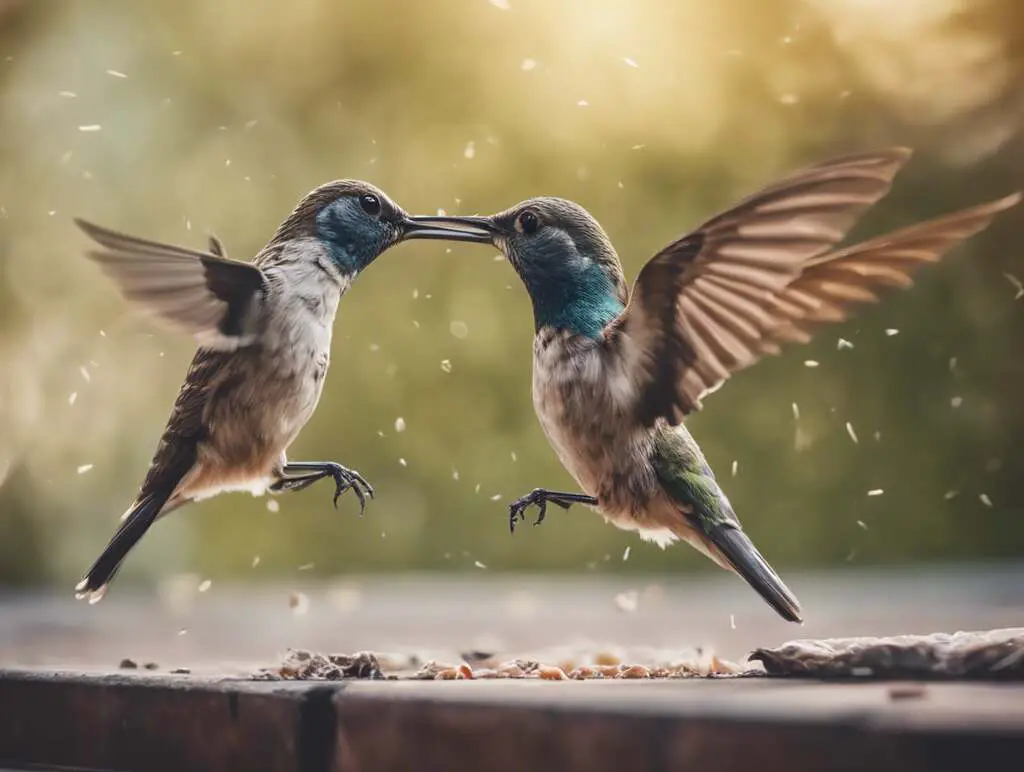Hummingbirds, known for their agility and vibrant plumage, are fascinating creatures to observe. One intriguing aspect of hummingbird behavior is their tendency to engage in fights with one another. These fights may seem aggressive and unnecessary at first glance, but there are specific reasons behind this territorial behavior.
Table of Contents
Reasons Behind Territorial Behavior in Hummingbirds Leading to Fights
Understanding Territorial Behavior in Hummingbirds
Hummingbirds are highly territorial creatures, especially when it comes to defending their sources of food. They rely on flower nectar as their primary source of nutrition, and competition for access to this vital resource can be fierce. Each hummingbird will defend a specific feeding territory, often a cluster of flowers, to ensure a consistent food supply.
Competition for Resources
One of the main reasons hummingbirds fight is the competition for limited resources. With their incredibly high metabolism, hummingbirds need to consume large amounts of nectar to fuel their energetic flight. This constant need for food drives them to fiercely guard their feeding territories and prevent intruders from stealing their nectar sources.
Mating Rights and Courtship Displays
In addition to competing for food, male hummingbirds may also engage in fights to establish mating rights. During the breeding season, male hummingbirds perform elaborate courtship displays to attract females. These displays can include aerial acrobatics, flashy plumage displays, and vocalizations. Engaging in fights with rival males is a way for hummingbirds to assert dominance and secure their position as the preferred mate.
Establishment of Hierarchy
Hummingbirds are hierarchical creatures, with dominant individuals claiming the best feeding territories. Establishing a clear hierarchy helps minimize conflict and maintain order within a hummingbird population. Fights between hummingbirds serve to reinforce this social structure, with stronger individuals asserting their dominance over weaker rivals.
Defense of Nesting Sites
Another reason behind hummingbird fights is the defense of nesting sites. Female hummingbirds meticulously select and defend their nesting locations to ensure the safety of their eggs and chicks. Males may also assist in defending the nest and territory from potential threats, including other hummingbirds.
Hummingbirds fight primarily due to territorial behavior driven by the competition for resources, mating rights, establishment of hierarchy, and defense of nesting sites. These seemingly aggressive interactions play a crucial role in the social dynamics and survival of hummingbird populations. By understanding the reasons behind hummingbird fights, we can gain a deeper appreciation for these remarkable birds and the complexities of their behavior in the wild.
Impact of Habitat and Food Source Availability on Hummingbird Aggression Levels
Hummingbirds are fascinating creatures known for their agility, vibrant colors, and unique behaviors. One intriguing behavior displayed by hummingbirds is their propensity to engage in fights. These aggressive interactions among hummingbirds are often a result of competition for resources, primarily habitat and food sources. Understanding the impact of habitat and food source availability on hummingbird aggression levels sheds light on their behavior and interactions in the wild.
Key Factors Influencing Hummingbird Aggression Levels
Importance of Habitat
Habitat plays a crucial role in shaping hummingbird behavior, including their aggressive tendencies. Hummingbirds are highly territorial and will defend their habitats against intruders. A lack of suitable nesting sites and perches can lead to increased aggression as hummingbirds compete for limited space. Moreover, the quality of the habitat, such as the presence of flowers for nectar and insects for protein, directly impacts the availability of food resources, further influencing aggressive interactions among hummingbirds.
Availability of Food Sources
Food sources, particularly nectar-rich flowers and small insects, are essential for the survival of hummingbirds. In environments where food is scarce or unevenly distributed, hummingbirds may exhibit heightened aggression to secure access to limited resources. Competition for nectar-producing flowers, in particular, can escalate aggressive encounters between hummingbirds as they strive to meet their energy requirements for flight and metabolism.
Intraspecific Competition
Intraspecific competition, or competition between members of the same species, is a driving force behind hummingbird aggression. Male hummingbirds, in particular, are known for their territorial behavior and aggressive displays to establish dominance and attract mates. Female hummingbirds also engage in competitive behaviors to defend nesting sites and ensure access to food for themselves and their young. The combination of limited resources and reproductive opportunities intensifies intraspecific competition among hummingbirds, leading to frequent fights and territorial disputes.
Behavioral Adaptations and Strategies
Hummingbirds have evolved unique behavioral adaptations to optimize their foraging efficiency and minimize unnecessary energy expenditure. By closely monitoring the availability of food sources within their territories, hummingbirds can prioritize high-quality feeding sites and minimize conflicts with rivals. Additionally, rapid and agile flight abilities enable hummingbirds to evade potential threats and assert dominance during aggressive encounters. These behavioral strategies help hummingbirds navigate competitive environments and maintain their energy balance amidst frequent territorial disputes.
Implications for Conservation and Research
Studying the impact of habitat and food source availability on hummingbird aggression levels is essential for conservation efforts and wildlife management. By identifying key factors that influence aggressive behaviors in hummingbirds, conservationists can implement targeted strategies to protect critical habitats, preserve biodiversity, and mitigate human-induced threats. Furthermore, ongoing research on hummingbird behavior provides valuable insights into ecosystem dynamics and the interconnectedness of species within their natural environments.
The interplay between habitat quality, food availability, and intraspecific competition significantly influences hummingbird aggression levels. By exploring these key factors and understanding their implications for hummingbird behavior, we gain a deeper appreciation for the complexity of interactions in the natural world. As we continue to unravel the mysteries of hummingbird ecology, conservation initiatives can be tailored to support these remarkable avian species and the ecosystems they inhabit.
Conclusion
Hummingbirds are fascinating creatures known for their vibrant colors, agile flight patterns, and territorial behavior. The reasons behind their territorial nature often lead to intense fights among these tiny birds. Understanding the impact of habitat and food source availability on hummingbird aggression levels provides valuable insights into their behavior.
Territorial behavior in hummingbirds is primarily driven by the need to protect valuable resources such as food sources and nesting sites. These resources are crucial for their survival and reproductive success. Hummingbirds fiercely defend their territories from intruders to ensure access to these essential resources. The availability of food plays a significant role in shaping their territorial behavior. When food sources are limited, hummingbirds become more aggressive in defending their feeding areas. This competition for food can escalate into intense fights between rival individuals.
In addition to food availability, the habitat plays a crucial role in influencing hummingbird aggression levels. Hummingbirds are highly adaptable birds that can thrive in various environments, from tropical rainforests to urban gardens. However, changes in their habitat due to deforestation, urbanization, or climate change can impact their behavior. Loss of suitable feeding areas or nesting sites can lead to increased competition among hummingbirds, resulting in more frequent fights.
Moreover, the presence of competitors such as other hummingbird species or even larger birds can trigger territorial disputes. Hummingbirds have been observed engaging in aggressive behaviors not only towards members of their species but also towards other bird species that pose a threat to their resources. This competitive behavior is a survival strategy that ensures their access to vital resources in the face of competition.
The reasons behind territorial behavior in hummingbirds leading to fights are deeply rooted in their instinctual drive to secure resources for survival and reproduction. The availability of food sources, the quality of the habitat, and the presence of competitors all influence the aggression levels displayed by hummingbirds. By studying these factors, researchers can gain valuable insights into the fascinating world of hummingbird behavior and ecology.
As we continue to explore and appreciate the intricate dynamics of hummingbird behavior, it becomes evident that these tiny birds are not just beautiful creatures but also fierce competitors in the natural world. Their determination to defend their territories and ensure access to essential resources highlights the complexities of their behavior.
By protecting their habitats and preserving the ecosystems they rely on, we can help safeguard the future of these amazing creatures and ensure that hummingbirds continue to enchant us with their dazzling displays of aerial acrobatics and colorful plumage.



